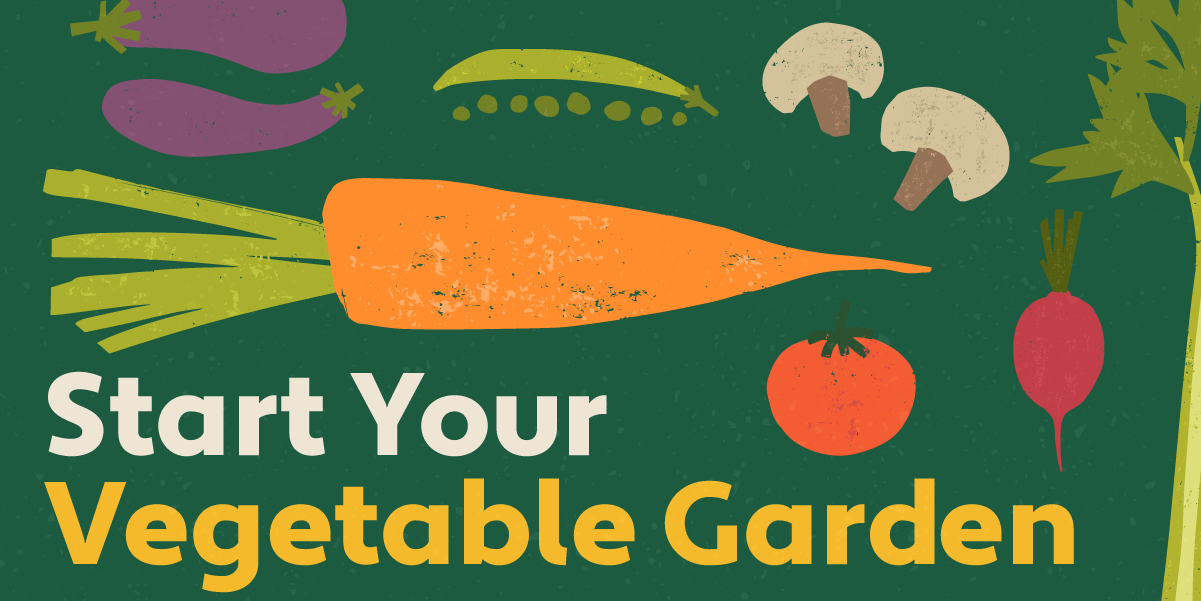Industrial agriculture enables Planet Earth to support a human population of over 8 billion in 2025.
Without modern farming methods, there would be widespread famine, disease, and all the miseries associated with food deprivation.
Commercial farming is a miracle, but it comes at a cost.
- It’s resource intensive
- It depletes water at an alarming rate
- It relies heavily on toxic chemicals
- It accounts for 10.6 percent of US greenhouse gas emissions
- It has cost America up to 40% of its topsoil
- It has led to a loss of biodiversity
- It contributes to deforestation and the destruction of natural habitats
Yikes! It’s enough to make you stop eating altogether!
So it’s a good thing that more and more people are picking up a spade, turning the soil in their backyard, and growing their own food. A home vegetable garden reduces their carbon footprint, saves money on groceries, and generates fresh, nutritious, flavorful produce for the entire family.
Plus, home gardening is rewarding and fun!
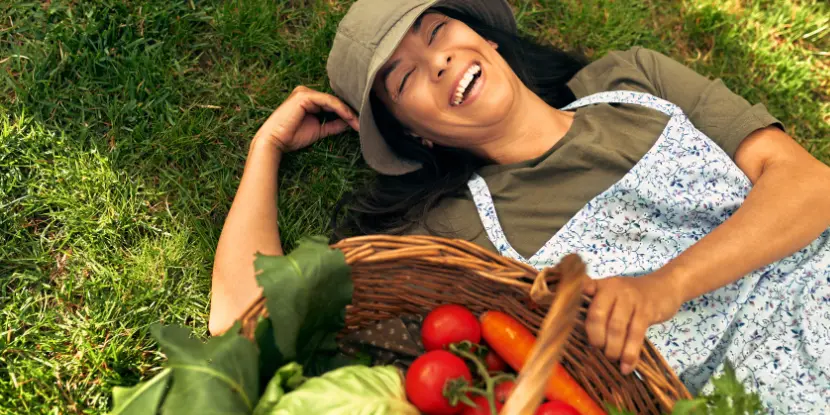
Outdoor gardening exposes you to the sun and your daily dose of vitamin D for better sleep.
Why Start a Vegetable Garden?
We’ve covered the many reasons in another blog. So we’ll cover only our top 5 reasons here:
1. Produce is fresher and more nutritious.
In commercial agriculture, produce is picked before it’s ripe to endure long transportation and shelf times. This results in fruits and vegetables lacking the full complement of nutrients and flavors they would have developed had they ripened on the plant.
When you control the gardening schedule, you can harvest home-grown produce at the peak of ripeness and enjoy all the vitamins, minerals, and antioxidants that nature intended.
2. Freshly-picked vegetables have a sweeter, richer flavor.
When was the last time you took a bite out of a homegrown tomato and thought, “Now, that’s how a tomato should taste!”
Home gardeners can choose vegetable varieties for flavor rather than their ability to last beyond the harvest. No more waxy, bland tomatoes or limp cucumbers. Vegetables grown organically and picked at their ripeness peak taste better.
You’ll find that even green beans, carrots, and celery are far tastier when grown at home.
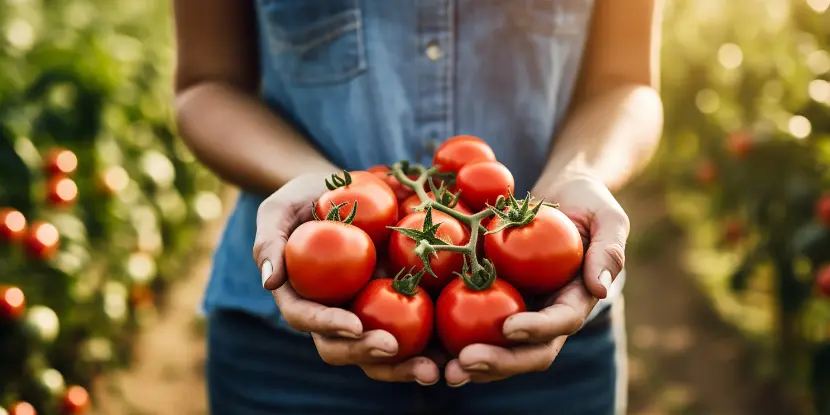
A harvest of delicious home-grown tomatoes.
3. You save money on organic produce.
Organic produce costs more because pesticide-free farming requires more manual labor. So, when you grow your organic vegetables, you save money on groceries. You’re providing the labor for free.
Producing your own food is an investment that pays off in health benefits, delicious meals, and family bonding.
4. It’s a fun and rewarding hobby
Gardening is a form of therapy. It’s therapeutic to work with your hands, watch plants grow from tiny seeds into bountiful crops, and enjoy the literal fruits of your labor.
It’s also a great way to get fresh air and exercise while spending time outdoors. Light-skinned gardeners need only 15 minutes in the sun to get their daily dose of vitamin D!
Kids who help in the garden are more likely to eat their veggies. They’ll enjoy watering, digging holes, and harvesting the produce — and squawk much less when it lands on their plate.
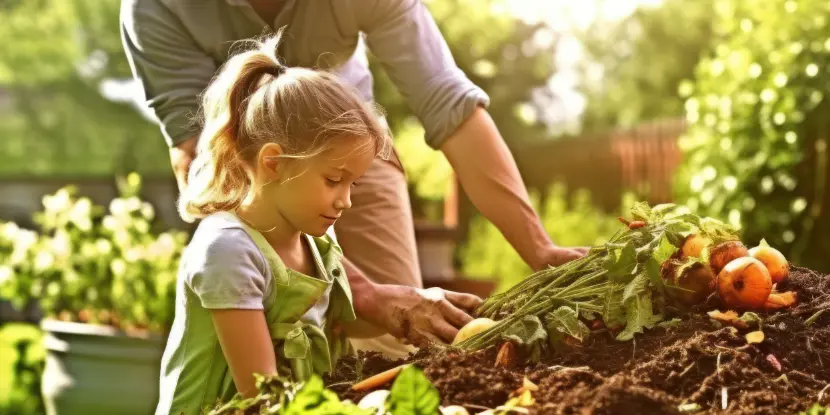
Growing your own food can be a way for families to bond and for children to learn about nature.
5. Home gardening promotes sustainability
Starting a vegetable garden reduces your dependence on commercial agriculture — and its environmental impacts — while fostering a connection with nature.
As you nurture your plants, you’ll develop a deeper appreciation for the natural world and the delicate balance of ecosystems. By implementing sustainable practices like composting, water conservation, and natural pest control, you contribute to a healthier planet for future generations.
Starting Your Vegetable Garden
Choose a Suitable Spot
Your garden should be in an area with at least 6 hours of sunlight daily.
- It should be close to a water source.
- It should have good soil drainage. No depressions or standing water!
- If space is limited, consider container gardening, a raised garden bed, vertical gardening, or hydroponic gardening.
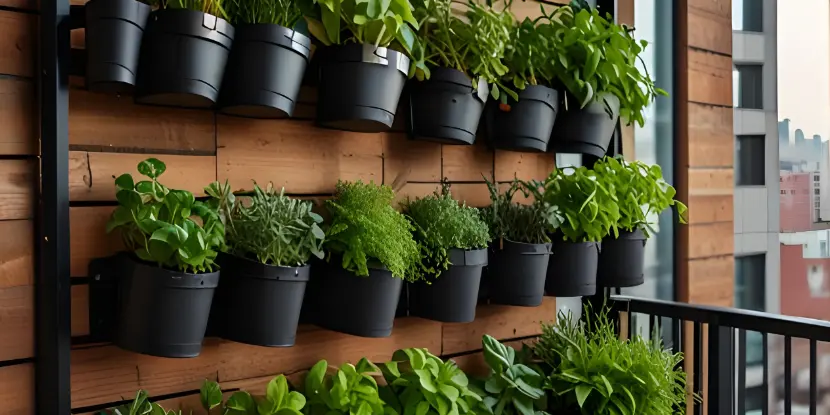
A vertical container garden mounted on a balcony wall.
Prepare the Garden Bed
- Soil should be loose, well-draining, and rich in nutrients.
- Remove any weeds, grass, or debris. This ensures your vegetables don’t have to compete for nutrients and water.
- Define the edges of your garden bed with string, stakes, or landscape timbers. This will make it easier to maintain.
- Use a spade, fork, or rototiller to break up and loosen the soil to a depth of about 12–15 inches. This allows roots to penetrate and improves air circulation.
- Mix in compost, manure, or other organic matter to improve soil fertility and structure. Incorporate 2–3 inches of organic matter into the top 6–8 inches of soil for best results.
- If the soil is heavy clay, add sand or perlite to improve drainage.
- Rake the soil surface level to ensure even water distribution and prevent waterlogging or runoff.
- Lightly water the prepared soil to settle it and make it easier to work with when planting.
- Consider adding a layer of mulch to help retain moisture, suppress weeds, and enhance soil fertility. Organic mulches like straw, wood chips, or leaf mold work best.
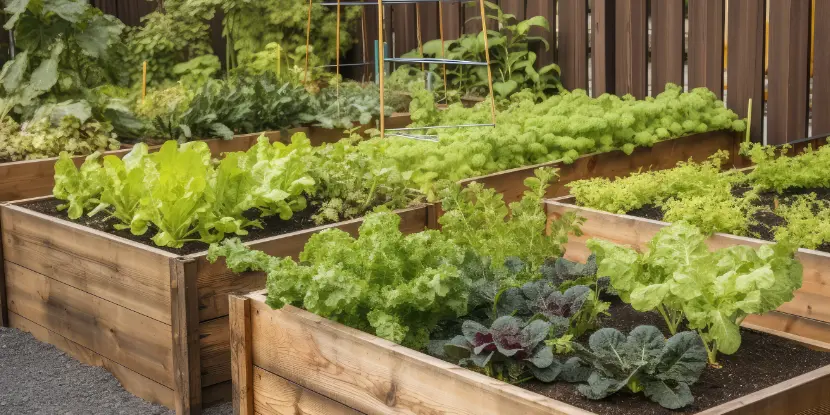
Raised garden beds with various vegetable plants.
Choose Your Vegetables
Start simple. We recommend planting the following vegetables and herbs:
These are all easy to grow, require minimal space, and provide a good variety for meals.

A small lettuce garden using hydroponic technology.
As your confidence and knowledge grow, you can expand your vegetable garden to include more challenging crops.
Plant Your Vegetables
- Each plant has specific spacing, planting depth, and sunlight needs. Follow the instructions provided.
- Dig small holes for your seedlings or seeds. The depth and spacing will vary depending on the type of vegetable.
- For seeds: Drop them into the holes and cover them with soil, following the recommended depth on the packet.
- For seedlings: Gently remove the plants from their containers without damaging the roots. Place them in the holes and cover them with soil, pressing down gently to secure them.
- After planting, water the soil well to settle the plants and eliminate air pockets. The soil should be moist but not soggy.
- Use plant markers or DIY labels to identify the different vegetables in your garden. This helps with plant care and future harvesting.
- Apply a layer of mulch around the base of your plants to retain moisture, suppress weeds, and regulate soil temperature. Organic mulch like straw or wood chips works best.
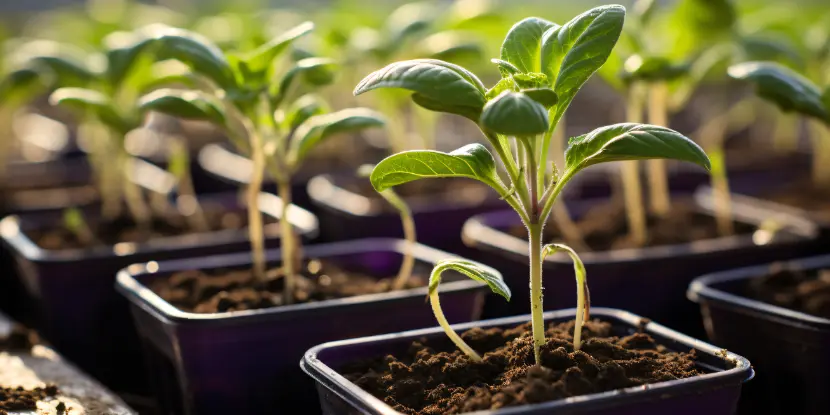
Eggplant seedlings ready for transplanting.
Caring for Your Garden
Water & Fertilizer
Watering
- Before watering, check the soil moisture by inserting your finger about an inch into the soil. If it feels dry, it’s time to water.
- Water your vegetable plants thoroughly so the water penetrates at least 6 inches into the soil. This encourages deep root growth.
- Water less frequently but thoroughly rather than lightly and often. This helps plants develop drought resistance.
- Water early in the morning or late evening to reduce evaporation and prevent fungal diseases.
- Apply a layer of mulch around your plants to help retain soil moisture and reduce watering frequency.

A drip irrigation system watering young cucumber plants.
Fertilizer
- Choose an organic or slow-release fertilizer suitable for vegetables. Look for balanced formulations containing nitrogen (N), phosphorus (P), and potassium (K).
- Always follow the manufacturer’s instructions for the correct application rate and frequency. Over-fertilizing can burn plants or cause excessive foliage growth at the expense of fruits.
- Apply the fertilizer evenly around the base of the plants, being careful not to directly contact the stems or leaves.
- For most vegetables, a good rule of thumb is to fertilize when planting, when the plants start to flower, and again when they begin to bear fruit.
- After applying fertilizer, water your plants to dissolve the nutrients and transport them to the roots.
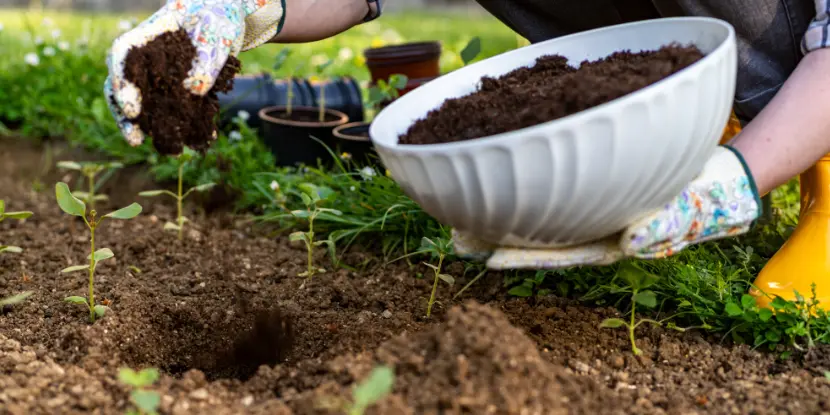
A gardener enriches garden bed soil with compost.
Pest & Disease Control
- Watch for signs of distress like discolored leaves, holes in foliage, or unusual growth patterns.
- Practice crop rotation, plant disease-resistant varieties, and space plants adequately to improve air circulation and reduce moisture-related diseases.
- Regularly inspect your plants and remove pests by hand. Use a strong stream of water to dislodge pests like aphids or spider mites.
- Introduce natural predators like ladybugs, lacewings, and predatory beetles to control pest populations.
- Use homemade or commercially available organic sprays like neem oil, insecticidal soap, or garlic spray to deter pests. Always follow the label instructions for safe application.
- Plant herbs and flowers like marigolds, basil, and nasturtiums alongside your vegetables to repel pests naturally.
- Apply organic mulch to suppress weed growth and prevent soil-borne diseases from splashing onto plants during watering.
- Maintain healthy soil with regular compost and organic matter applications, which boosts plant immunity and resilience against diseases.
- Regularly prune diseased plant parts and dispose of them properly. Keep the garden free of debris where pests and diseases can thrive.
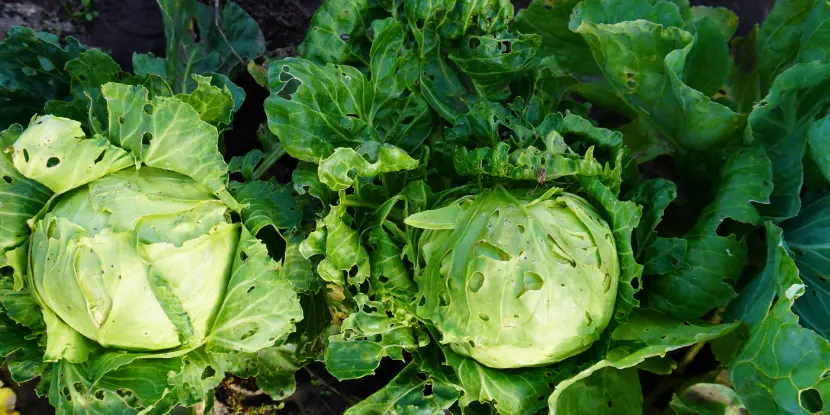
Cabbage damaged by uncontrolled pests.
Harvesting Your Vegetables
- Most vegetables are ready for harvest when the fruits have reached their mature size, color, and flavor.
- Use a sharp knife or scissors to cut fruits from the plant to avoid damaging stems or roots.
- Wash your hands thoroughly before handling harvested vegetables to prevent contamination.
- Harvest leafy greens by picking individual leaves as needed. This allows the plant to continue producing new foliage over an extended period.
- Store freshly picked vegetables in a cool, dark place until ready to use them. Rinse with cold water just before consumption.
- Share your extra produce with friends and neighbors or donate it to a local food bank or shelter.

Sweet peppers ready to for harvest.
Final Thoughts
Are you raring to go now? To unleash your inner Johnny Appleseed, or Carol Cabbage Patch, as the case may be?
Then, head to your local Anawalt Garden Center to purchase the fertilizer, mulch, tools, and plants you’ll need to start your vegetable garden today.
We have a huge selection of seeds and seedlings, organic fertilizers, and pest control products, and a friendly and knowledgeable staff is available to help you with any questions or concerns.
FAQs: How to Start a Vegetable Garden
Q: When is the best time to start a vegetable garden?
That depends on your location and climate. In general, you should start planting after the last frost in the spring. However, some cool-season crops can be planted earlier in the year.
Q: Can I use any old soil type for my vegetable garden?
Using a well-draining, nutrient-rich soil mix specifically designed for growing vegetables is best. To improve quality, you can also amend your soil with compost or other organic matter.
Q: How often should I water my vegetable garden?
This will depend on factors like your climate, soil type, and the types of plants you’re growing. As a general rule, aim to keep the soil consistently moist but not saturated.
Q: How do I know when to harvest my vegetables?
Refer to the seed packet or plant label for estimated maturity dates. You can also inspect or taste-test fruits to determine if they’re ready for harvest.
Q: Do I need much space to have a vegetable garden?
Not necessarily! You can grow vegetables in containers, raised beds, or vertically using trellises or hanging baskets. Just ensure your plants have enough room to grow and receive ample sunlight.
Q: Can I still start a vegetable garden if I don’t have a green thumb?
With proper planning, care, and a little trial and error, anyone can grow their own vegetables. Don’t be afraid to ask for help or do research before starting. So go ahead, choose your favorite vegetables, and prepare to enjoy the fresh flavors of your homegrown produce all season long!

